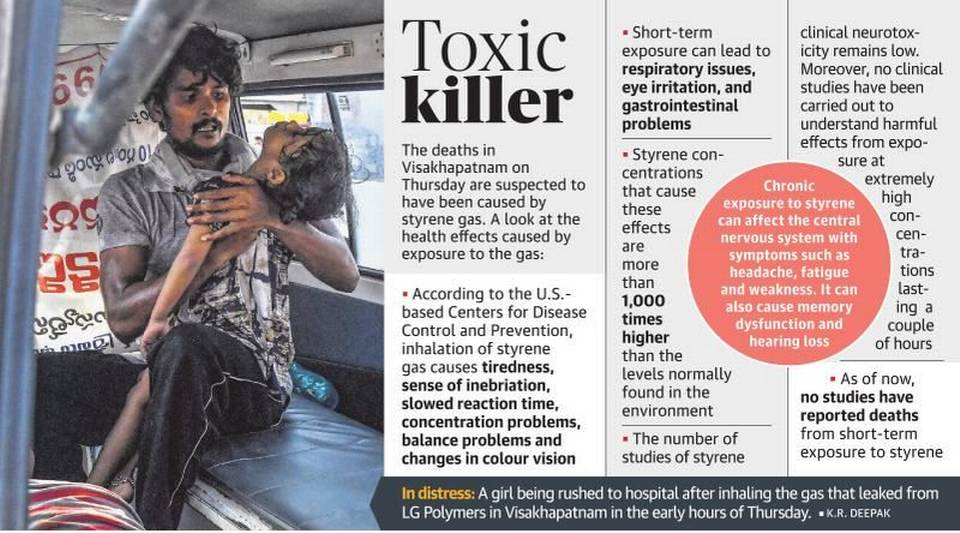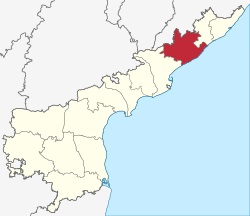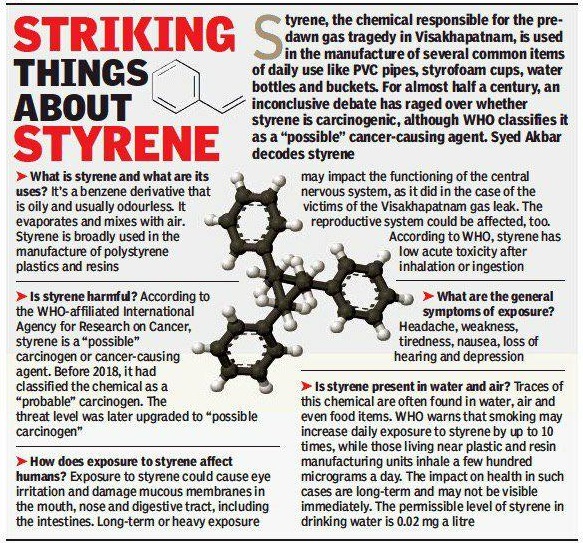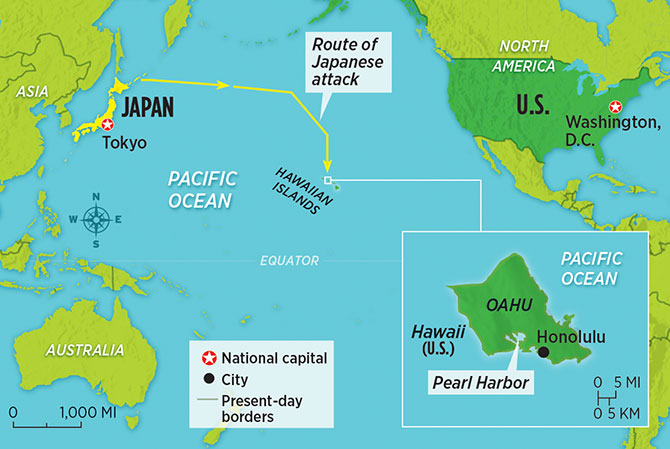Contents
- Visakhapatnam gas leak
- No scientific studies report styrene gas causing deaths
- Vande Bharat Mission
- Madhya Pradesh pushes working hours
- U.S. recognises India’s role in Afghanistan
- Trump: COVID crisis ‘worse than Pearl Harbor’ or 9/11
VISAKHAPATNAM GAS LEAK
Focus: GS-III Disaster Management, Science and Technology
Why in news?
Eleven people, including a six-year-old girl, died and over 350 were admitted to hospitals after styrene monomer gas leaked from a chemical plant belonging to LG Polymers at RR Venkatapuram in Visakhapatnam on 7th May 2020.
Details and Case Registered

- The company was earlier called Hindustan Polymers. It was taken over by the South Korea-based LG Chem in 1997.
- It manufactures polystyrene, a basic material used in fibreglass and rubber for making toys and appliances.
- The Gopalapatnam police have registered a case against the management of LG Polymers under Sections 278 (making atmosphere noxious to health), 284 (Negligent conduct with respect to poisonous substance), 285 (Negligent conduct with respect to fire or combustible matter), 337 (Causing hurt by act endangering life or personal safety of others), 338 (Causing grievous hurt by act endangering life or personal safety of others and 304 (II) of the IPC.
Handling the Gas Leak
- Police said: The gas was not lethal, but prolonged exposure to it could affect the central nervous system, which may lead to depletion of oxygen to the brain and cause nausea, vomiting and breathlessness.
- Following the leak, the company and the district administration took up elaborate sprinkling of water inside the plant and in the affected areas.
Bits about Visakhapatnam

- Visakhapatnam (aka Vizag) is a coastal city in Andhra Pradesh, that lies between the Eastern Ghats and the coast of the Bay of Bengal.
- The city is set to become the executive capital of Andhra Pradesh once a decentralization bill is enacted the Andhra Pradesh Legislative Assembly.
- It is one of the four smart cities of Andhra Pradesh selected under Smart Cities Mission.
- The city is home to the oldest shipyard and the only natural harbour on the east coast of India.
- Visakhapatnam Port is the fifth-busiest cargo port in India, and the city is home to the headquarters of the Indian Navy’s Eastern Command and South Coast Railway zone.
- It has been nicknamed the “City of Destiny” and the “Jewel of the East Coast”.
Gas Leak in the Past: Bhopal Gas Tragedy
- The Bhopal disaster, also referred to as the Bhopal gas tragedy, was a gas leak incident on the night of 2–3 December 1984 at the Union Carbide India Limited (UCIL) pesticide plant in Bhopal, Madhya Pradesh.
- It is considered to be the world’s worst industrial disaster.
- Over 500,000 people were exposed to methyl isocyanate (MIC) gas a highly toxic substance that made its way into and around the small towns located near the plant.
- The initial effects of exposure were coughing, severe eye irritation and a feeling of suffocation, burning in the respiratory tract, blepharospasm, breathlessness, stomach pains and vomiting.
- Thousands of people had died by the following morning, primary causes of deaths were choking, reflexogenic circulatory collapse and pulmonary oedema.
NO SCIENTIFIC STUDIES REPORT STYRENE GAS CAUSING DEATHS
Focus: GS-III Science and Technology
Why in news?
The gas leak from LG Polymers, which led to the death of at least seven people in Visakhapatnam, is suspected to have been caused by styrene gas.
Details

Effects of Styrene Gas According to various studies
- The most common health problems when exposed to styrene involve the nervous system — both the central and the peripheral nervous systems.
- According to the Atlanta-based Centers for Disease Control and Prevention (CDC), the health effects due to inhalation of styrene gas include tiredness, feeling drunk, slowed reaction time, concentration problems, balance problems and changes in colour vision.
- The styrene concentrations that cause these effects are more than 1,000 times higher than the levels normally found in the environment.
- According to the U.S.-based Environmental Protection Agency (EPA), short-term exposure to styrene can lead to respiratory effects, such as mucous membrane irritation, eye irritation, and gastrointestinal effects. Chronic exposure can cause effects in the central nervous system with symptoms such as headache, fatigue, weakness. It can also cause central nervous system dysfunction including memory, visuomotor speed, hearing loss and peripheral neuropathy.
Were the deaths caused by Styrene?
- The number of studies of styrene clinical neurotoxicity is rather small.
- Acute exposure to styrene via inhalation at 376 ppm for 25 minutes had resulted in nausea, a sense of inebriation and headache.
- But no studies have been carried out to understand the harmful effects from exposure at extremely high concentrations lasting a couple of hours.
- Currently, no studies have reported deaths from short-term exposure to styrene gas.
- Hence, it is not clear if the deaths were caused by styrene gas or some other chemical or a combination.
VANDE BHARAT MISSION
Focus: GS-II Social Justice
Why in news?
The Vande Bharat Mission to bring stranded Non-Resident Keralites back home in the wake of a global lockdown following the COVID-19 pandemic got off to a firm start with two flights from the Gulf carrying 363 passengers touching down at the Cochin and Karipur airports on 7th May 2020.
Vande Bharat Mission
- India launched Vande Bharat Mission with Air India flights ferrying out passengers stranded in India and this Mission is claimed to be the biggest repatriation exercise ever.
- ‘Vande Bharat Mission’ will see the operation of 64 flights from May 7 to May 13 to bring back around 15,000 Indian nationals stranded abroad.
Air Evacuations in the Past
- The 1990 airlift of Indians from Kuwait was carried out from August 13, 1990 to October 20, 1990 after the Invasion of Kuwait.
- Air India helped evacuate 170,000 people by civil airliners.
- The operation was carried out before the Persian Gulf War in 1990 to evacuate Indian expatriates from Kuwait.
- Air India, the flag carrier Indian airline entered the Guinness Book of World Records for the most people evacuated by a civil airliner.
MADHYA PRADESH PUSHES WORKING HOURS
Focus: GS-III Disaster Management
Why in news?
Madhya Pradesh on 7th May 2020 allowed employers to increase working hours in factories by four hours, from eight to 12. It has also allowed up to 72 hours a week in overtime.
Highlights
- The increased working hours are applicable only if employees are willing to work. And they must be paid for overtime.
- And industries can change shifts at their convenience and New industries will be exempted from all Sections of the Factories Act, 1948.
- A proposal has been sent to the Central government for amendments to this Act, the Public Relations Department said.
What is Not mandatory now?
- The new units will be exempted from the entire Section in the Act on ‘right of workers’ that empowers workers to obtain details of their health and safety at work.
- Further, the employer is not bound to provide to workers ventilation, lighting, toilets, sitting facilities, first aid boxes, protective equipment, canteens, crèches, weekly holidays and interval of rest.
- Not even providing drinking water is mandatory now.
- Maintenance of register of adult and child workers and allowing for advance payments will not apply to new units.
- They can even get away without maintaining cleanliness on premises and ensuring safe disposal of waste and effluents.
Why are these Labour Reforms introduced?
- Many firms across the world want to relocate now. And we want to invite them here.
- Industries have been demanding labour reforms for long.
- The changes, with workers’ rights kept in mind, became necessary as investors were stuck in a web of laws and red-tapism.
U.S. RECOGNISES INDIA’S ROLE IN AFGHANISTAN
Focus: GS-II International Relations
Why in news?
The U.S. recognises India’s “constructive contribution” to Afghanistan, said U.S. Special Representative for Afghanistan reconciliation.
Details
- The U.S. side recognised India’s constructive contribution in economic development, reconstruction and humanitarian assistance to Afghanistan.
- They laid importance to India’s crucial and continuing role in sustainable peace, security and stability in Afghanistan.
- Expressing deep concern about the increase in violence in Afghanistan, Indian Foreign Minister made a particular mention of the need to protect “Afghan Hindus and Sikhs,” and said India supported the call for a ceasefire to deal with the coronavirus pandemic.
- EAM and NSA reiterated India’s continued support for strengthening peace, security, unity, democratic and inclusive polity and protection of rights of all sections of the Afghan society, including Afghan Hindus and Sikhs.
- In a reminder of India’s concerns over Pakistan’s role, the MEA emphasised that putting an end to terrorist safe havens and sanctuaries is necessary for enduring and sustainable peace and stability in Afghanistan.
Read More About the U.S. – Taliban Deal at: https://www.legacyias.com/us-deal-with-taliban/
Read More About India’s Concerns with the U.S. – Taliban deal at: https://www.legacyias.com/india-monitoring-impact-of-u-s-taliban-deal-2/
TRUMP: COVID CRISIS ‘WORSE THAN PEARL HARBOR’ OR 9/11
Focus: GS-II International Relations
Why in news?
- Donald Trump has said the COVID-19 pandemic is a worse “attack” on the U.S. than either Pearl Harbor or 9/11.
- The Japanese assault on the Pearl Harbor naval base in Hawaii drew the United States into Second World War.
- The September 11, 2001 jihadist attacks on that killed about 3,000 people and triggered two decades of war.
Attack on Pearl Harbor
- The attack on Pearl Harbor was a surprise, preemptive military strike by the Imperial Japanese Navy Air Service upon the United States (a neutral country at the time) against the naval base at Pearl Harbor in Honolulu, Territory of Hawaii.
- The attack led to the United States’ formal entry into World War II the next day.
- Japan intended the attack as a preventive action to keep the United States Pacific Fleet from interfering with its planned military actions in Southeast Asia against overseas territories of the United Kingdom, the Netherlands, and the United States.




